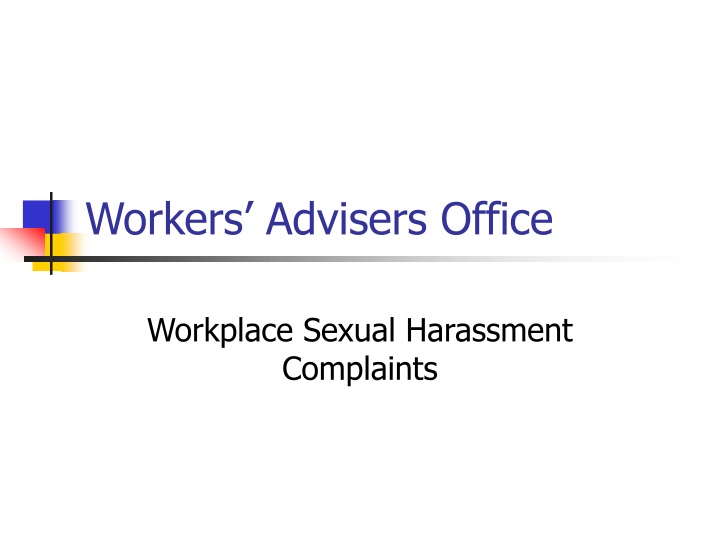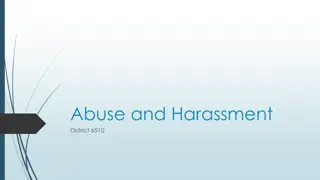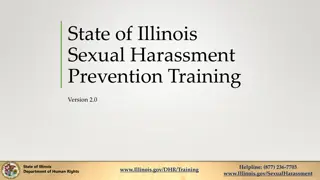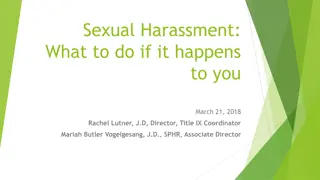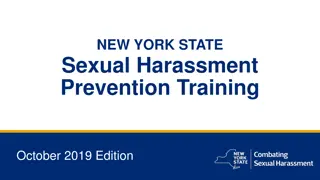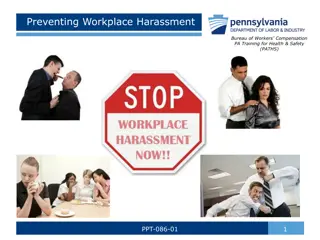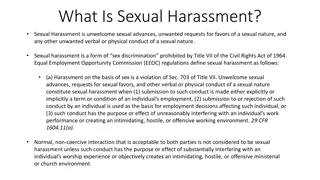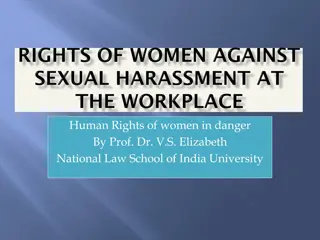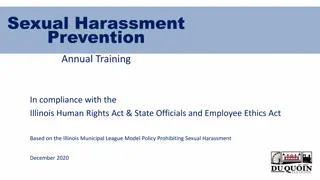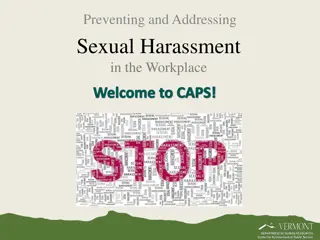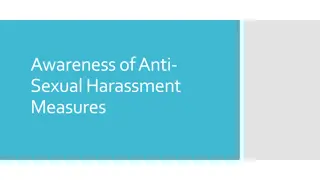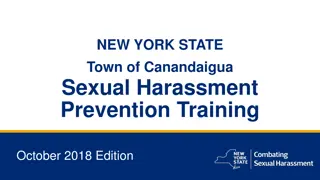Workers Advisers Office: Addressing Sexual Harassment Complaints
The Workers Advisers Office, a branch of the Ministry of Labour, provides free advice and assistance to workers on compensation claims and prohibited action complaints, including those related to sexual harassment. They handle compensation claims for injuries and diseases, as well as mental disorder claims like bullying and harassment. The office assists workers in filing claims and complaints while ensuring independent and merit-based representation. When workers face retaliation for reporting safety concerns or harassment, they can seek help from the Workers Advisers Office for legal guidance and support.
Download Presentation

Please find below an Image/Link to download the presentation.
The content on the website is provided AS IS for your information and personal use only. It may not be sold, licensed, or shared on other websites without obtaining consent from the author.If you encounter any issues during the download, it is possible that the publisher has removed the file from their server.
You are allowed to download the files provided on this website for personal or commercial use, subject to the condition that they are used lawfully. All files are the property of their respective owners.
The content on the website is provided AS IS for your information and personal use only. It may not be sold, licensed, or shared on other websites without obtaining consent from the author.
E N D
Presentation Transcript
Workers Advisers Office Workplace Sexual Harassment Complaints
Our Mandate The Workers Advisers Office is a Branch of the Ministry of Labour Workers Compensation Act s. 351 Operates independently of WorkSafeBC Free advice and assistance to workers, dependants and other parties regarding workers compensation. Represent if there is merit Training/mentoring to third parties
When to refer clients to WAO For compensation claims, if the client has a claim number and a decision from WorkSafeBC. For prohibited action complaints, if the client has filed a complaint with the AGCD and has a complaint number.
Compensation Claims v. Prohibited Action Complaints Compensation claims addressed under sections 134, 135, 136, 145 of the Act Mental disorder claims addressed under section 135, including claims for bullying and harassment. Prohibited Action (PA) Complaints addressed under s 47 to 50 of the Act.
Compensation Claims v. Prohibited Action Complaints Compensation claims address acceptance of claim for injury or disease. PA deals with whether the employer retaliated against a worker for protected occupational health and safety activities. For example, PA deals with whether a worker reported being harassed, not whether harassment actually occurred, or caused a mental disorder.
Parallel Compensation Claim and PA Complaints Sometimes a worker will have a PA complaint and a compensation claim. For example, a worker who reports to their employer that they are being harassed by a co-worker, but the employer fires them for reporting this safety matter. The same worker may file a compensation claim if they have a mental disorder as a result of the harassment
Compensation Claims Regarding Sexual Harassment Mental disorder claims s.135 Document events, seek medical attention, report to employer Claim must be filed within one year of injury. Late claims may be allowed (s 151)
Compensation Claims Regarding Sexual Harassment DSM mental disorder diagnosed by psychologist or psychiatrist Traumatic event or significant work- related stressor related to employment Traumatic event must be of causative significance to mental disorder Work-related stressor must be the predominant cause of the mental disorder
Compensation Claims regarding Sexual Harassment Aggravations of pre-existing mental disorders may also be accepted Mental disorders resulting from a decision of the employer regarding employment are excluded (S135(1)(c), with some exceptions S. 339(3) Board decision making
Compensation Claims regarding Sexual Harassment If claim denied there is a 90 day deadline to request review at Review Division. File through www.worksafebc.com 30 days from date of Review Division decision to appeal to WCAT File appeal through www.wcat.bc.ca
Prohibited Action To Every Action There is an Equal and Opposite Reaction (With apologies to Sir Isaac Newton) An Overview of the Law, Policies, Practices and Remedies Applicable to Prohibited Action
Objectives In this presentation you will learn: What amounts to Prohibited Action under the Workers Compensation Act (Act) How WorkSafeBC addresses Prohibited Action complaints The applicable mediation, adjudication and appeals processes.
Agenda The two types of complaints Circumstances in which complaints arise Onus of proof on the parties Limitations on making complaints Process Remedies to complaints Enforcement
Two Types of Complaints Failure to pay wages complaints Prohibited Action complaints
When Does a Failure to Pay Wages Complaint Arise? When a worker is not paid for: attending joint health and safety committee meetings and related duties as a member (s. 40(2)) educational leave for joint health and safety committee members (s. 41(3)) accompanying a WorkSafeBC officer on a workplace inspection (s. 78(4)) lay-off resulting from a WorkSafeBC stop work order (s. 93(1))
When Does a Prohibited Action Complaint Arise? When an employer retaliates against a worker, as contemplated by section 47 of the Act, in response to a worker s communication of occupational health or safety concerns, as contemplated by section 48 of the Act.
Workers Activities Under Section 48 Where a worker, in the context of occupational health and safety matters regulated by WorkSafeBC exercises any right (s. 48(a)); carrries out any duty (s. 48(a)); or gives information to certain persons (s. 48(c)) an employer cannot take or threaten to take retaliatory action against the worker.
Some Common Examples of Health and Safety Issues Refusal of Unsafe Work Bullying and Harassment Reporting of Breaches of the Occupational Health and Safety Regulation by Employer or Co-Workers
General Circumstances in Which Complaints Arise Section 48(c) This subsection of the Act captures workers general giving of information about occupational health and safety matters to: an employer another worker or union representing a worker a WorkSafeBC officer or any other person concerned with the administration of Part 2 of the Act
and the employer does something negative in response such as firing the worker
Employer Retaliation Under Section 47 suspension, lay-off or dismissal demotion or loss of opportunity for promotion transfer of duties, change of workplace location, change in working hours or reduction in wages imposition of any discipline, reprimand or other penalty coercion or intimidation
Onus of Proof on the Worker Worker must provide sufficient evidence to establish a prima facie case A prima facie case is a bare outline of a complaint that will prevail until contradicted and overcome by other evidence
Onus of Proof on the Employer There is a reverse onus on the employer (s. 49(4)) The employer can meet this onus, by proving on a balance of probabilities that: its actions are not captured by s. 47; the worker s activities are not captured by s. 48; or its actions were not motivated by considerations of the worker s health and safety activities.
Taint Principle The taint principle requires that in order to discharge the burden of proof under section 49(3) of the Act, the employer must prove that in no part were its actions under section 47 of the Act tainted by the worker taking any of the actions set out under section 48 of the Act. The employer must demonstrate that its reasons for taking action against the worker were not related to any of the prohibited grounds in Section 48. This means that the employer cannot shield itself by pointing to proper cause, or what may be a valid business reason for the impugned conduct, where there is also evidence of a prohibited action.
Statutory Time Limitations on Making Complaints Time Limits 1 year for Prohibited Action / 60 days for failure to pay wages Grievance A worker must choose whether to grieve or file a complaint Settled / Withdrawn WorkSafeBC must determine whether the complaint has been settled or withdrawn
Process Investigation by Prevention Officer Mediation by external service provider Adjudication by a Legal Adjudicative Officer (LAO)
WorkSafeBC Investigation A Prevention Officer will review the complaint for completeness and may carry out further inquiries. The Prevention Officer, if satisfied that the complaint is complete and within the jurisdiction of the Act, will refer it to the Prohibited Action Adjudication Team in the Associate General Counsel Department (AGCD) of WorkSafeBC. Typically mediation is offered when the complaint is received by the AGCD.
Mediation The worker and employer will be offered a referral to mediation. The mediation process is entirely voluntary and requires agreement by both parties to participate. WorkSafeBC appoints an external mediation provider. Variety of different mediators sometimes with different processes!
Mediation At mediation, mediator explains role; parties then invited to outline their positions. Frequent breaks for caucusing. If settlement terms agreed, these are outlined in a document (a Memorandum of Understanding of Settlement Agreement) Employers frequently ask the worker to sign a release of any other claims as a condition of settlement
Mediation WAO unable to advise worker on legal issues falling outside of statutory remit this includes other potential claims and any release/waiver thereof. Worker should be advised to seek independent legal advice as to any other potential claims before signing any release.
Mediation - Advantages Potentially much quicker resolution than adjudication/appeal process. Removes the risks inherent in waiting for adjudication (uncertain outcome, risk of employer bankruptcy etc.) Greater flexibility in terms of remedy. If there remains a working relationship between worker and employer, greater prospect of preserving that relationship if negotiated settlement achieved.
Initial Adjudication by Associate General Counsel Division If mediation is declined or unsuccessful, claim proceeds to adjudication. Employer is invited to file submissions in response to worker s complaint form. Worker is then invited to file response submission.
WCAT Appeals There is no second level of appeal in PA Claims that is comparable to the Review Division Either party may file an NOA with WCAT within 90 days of the AGCD decision Often a PA complaint results in 2 separate decisions adjudicating the PA Complaint (1) and the Remedy (2) with separate appeal rights
WCAT Oral Hearings Same WCAT rules of practice apply as with workers compensation appeals. Hearings are typically much longer than with compensation appeals. Often multiple witnesses requiring cross-examination.
Remedies Section 50(2) The object of Section 50(2) is to, as far as is practicable, put the worker in the same position they would have been in had the prohibited action not occurred ( make whole principle).
Specific Remedies Section 50(2) In accordance with Section 50(2), a decision-maker may order: reinstatement payment of lost wages payment of interest removal of reprimand references providing for letters of reference
Duty to Mitigate Worker has a duty to act diligently in seeking to mitigate his/her losses (replacing their lost wages by looking for other work). In cases of employment termination, worker should be able to demonstrate reasonable efforts to secure alternative employment. Worker should maintain documentary records to prove mitigation efforts. Failure to do so may adversely impact the level of compensation awarded.
Duty to Mitigate continued Onus is initially on worker to prove efforts to mitigate Onus shifts to employer who disputes mitigation efforts to prove worker has failed to do so. See WSBC Prevention Manual P2-50-2 (b) page 2.
Awards for Lost Wages Lost wages are generally calculated on the basis of common-law as opposed to Employment Standards legislation. The purpose of awarding remedies is, as far as is practicable, to put the worker in the same position as the worker would have been if the discriminatory action or failure to pay wages had not occurred. Wage replacement is subject to a duty to mitigate or lessen the loss. Severance pay is deducted from the entitlement period i.e. if the worker received two weeks severance pay and is found to be entitled to 4 weeks of lost wages, they would be entitled to a total of 2 weeks pay.
Evidence - General Types of Evidence to gather if available, including: pictures, letters, e-mails, memos, voice or audio recordings, internet information about the employer company including site pictures, texts; copies of personnel files, work performance appraisals, cards or thank you letters regarding performance; the worker s calendar or diary, Witness statements, medical reports or chart notes of patient visits; the worker s summary of what occurred, witness statements, letters or notes to co-workers or family members about the incident;
Evidence - Continued Evidence to support the Remedy request pay stubs, commission slips; job search lists, job advertisements, resumes, cover letters, reference letters, educational and professional certificates; T-4s, Record of Employment, income tax summaries. Worker s employment history (from resume)
Enforcement Aside from providing some general advice WAO does not get involved in the worker s enforcement of their remedy entitlements. WSBC does not actually enforce a worker's remedy entitlement on behalf of the worker. The worker may want to seek legal advice on the enforcement of their remedies.
WAO Process Request for Disclosure Review of Claim File Interview with Worker Merit Assessment different considerations for mediation vs adjudication by AGCD or WCAT.
Thank you For questions reach out to: Christina Dorsch at 250-900-4764 Or Toll free at 1-800-663-4261
